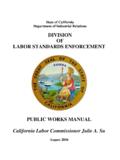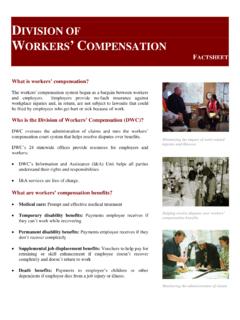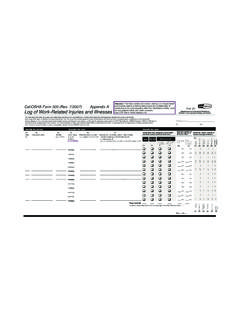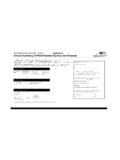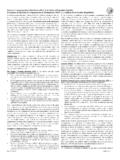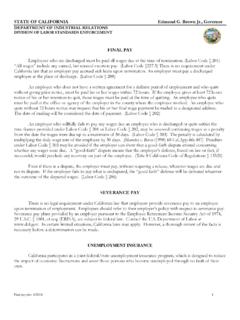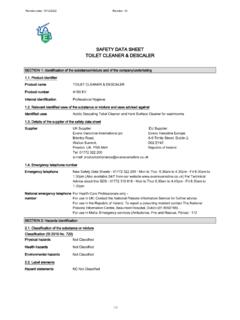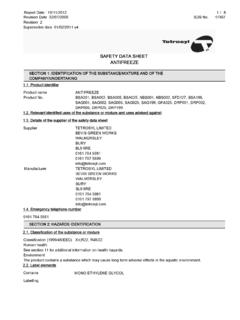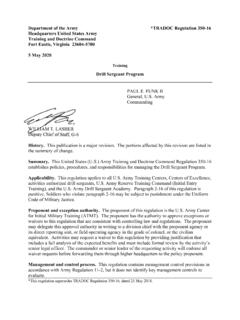Transcription of Fact Sheet on the Resource Based Relative Value Scale ...
1 Fact Sheet on the Resource Based Relative Value Scale ( rbrvs ) Fee schedule effective january 1, 2014. 1. When did the new rbrvs - Based fee schedule become effective ? The rbrvs - Based physician and non-physician practitioner fee schedule is effective for services rendered on or after january 1, 2014. The rule as initially adopted through rulemaking was Based upon Medicare's 2013 policies and RVUs. After reviewing Medicare's Physician Fee schedule 2014 Final Rule (issued November 27, 2013), the Division updated the workers' compensation Physician Fee schedule regulations in accordance with Labor Code by issuing and posting an Administrative Director update Order adopting relevant changes from the 2014 Medicare Physician Fee schedule . Although the Medicare Physician Fee schedule Final Rule is usually issued approximately November 1st, it was delayed in 2013 due to the federal government shutdown. The Update Order and regulations are posted on the Division's Official Medical Fee schedule (OMFS) web page: #7.
2 Part of that Order, the Administrative Director updates the links and documents incorporated by reference into title 8, Cal. Code Regs. The Order also updates the conversion factors to account for inflation in accordance with the Medicare Economic Index and the Relative Value Scale adjustment, if any. Physician Fee schedule uses the Medicare 2014 Relative Value units and 2014 CPT. codes. posted regulations include provisions adopted in the initial rulemaking action, in the clean up rulemaking (to eliminate use of federal Office of Workers' Compensation Program values), and in the Administrative Director's Update Order. 2. How does the rbrvs fee schedule work? The fee schedule has three components: Relative Value Units (RVUs) for each medical service measure the Relative resources associated with the physician's work (the time and skill required for the procedure), practice expenses (the staff time and costs of maintaining an office), and malpractice expenses.
3 The RVUs compare the resources required for one service to those required for other services. Relative to the pre-2014 OMFS, the rbrvs tends to provide lower Relative values for surgical and other technical procedures and higher Relative values for E&M. services. Most RVUs will be Based on Medicare's RVUs. If Medicare has not established RVUs for a reimbursable procedure code the services will be priced By Report. The pre-2014 OMFS set one RVU for each procedure, and did not list separate RVUs for physician work, practice expense and malpractice. The rbrvs - Based fee schedule adopts the Medicare Relative Value Scale file which sets forth separate RVUs for work, practice expense and malpractice. The pre-2014 OMFS set the same fee for a physician service regardless of where the service was rendered, the physician received the same fee if the procedure was performed in a physician office or at an inpatient facility. The rbrvs - Based fee 1.
4 February 2014. schedule adopts the Medicare approach which has different RVUs for physician services in a facility vs. a non-facility. Generally the physician non-facility . practice expense RVU is higher than the facility practice expense RVU. In the non- facility setting such as the physician's office, the physician bears higher overhead/practice costs than if the physician performed the service in a facility. The rbrvs - Based fee schedule sets out a table designating facility or non-facility . status for various place of service codes. A conversion factor (CF) is a dollar amount that is used in a formula to convert the RVUs into a payment amount for a service. The CF determines overall fee schedule payment levels. The fee schedule starts with separate conversion factors for surgery, radiology, and all other services in 2014 and transitions to a single CF beginning 2017, for all services except anesthesia. Anesthesia is priced under a different Scale (using base units and time units) and will continue to have a separate conversion factor.
5 The Anesthesia conversion factor also transitions during the period 2014 through 2017. A geographic adjustment factor (GAF) adjusts for geographic differences in the costs of maintaining a physician practice. Medicare uses adjustment factors for nine geographic areas or localities in California, but for California workers' compensation the regulations adopt statewide average GAFs. For services other than Anesthesia, the rbrvs - Based regulation reduces administrative complexity by using statewide average geographic adjustment factors for each RVU component, instead of Medicare's nine locality adjustments. For Anesthesia, there is one statewide GAF for all anesthesia procedures since anesthesia base units are not broken down into work, practice expense and malpractice components. The rbrvs - Based fee schedule will be updated annually, and will have mid-year updates as needed. The conversion factor will be updated Based on the increase in the Medicare Economic Index and any Relative Value Scale adjustment adopted by Medicare.
6 These updates are mandated by SB 863 (Labor Code section (b) (2) (A) (iii), (g)). The inflation adjustment, which does NOT include any adjustments for the Medicare sustainable growth rate (SGR). measure, should provide predictable and equitable annual adjustments Based on changes in the costs of maintaining a medical practice. SB 863 does not include the SGR as an update factor, and evidences intent to disallow the SGR to impact workers' compensation fees by specifying the July 2012 Medicare payment (which did not utilize SGR) as the benchmark. The SGR formula has been severely criticized, and for many years, Congress has passed bills to prevent the SGR from going into effect. rbrvs will be phased in over a four-year period through changes in the conversion factor applicable to each type of service. The conversion factors (set forth in 8 CCR. ), before adjustment for inflation and Relative Value Scale adjustment, are shown in Table 1.
7 (Since they must be adjusted for inflation and Relative Value Scale adjustment, the conversion factors in Table 1 are not the adjusted conversion factors that will be used in calculating payments.). 2. February 2014. Table 1. Transition Conversion Factors Before Adjustments for Inflation/RV Scale Adjustment Type of RAND 120% 2012 2014 CF 2015 CF 2016 CF 2017 CF. a Service Budget- Medicare 75/25 50/50 25/75 120%. Neutral CF Blend Blend Blend Medicare Anesthesia Surgery Radiology All other services a The Medicare 2012 CFs for anesthesia and all other services are $ and $ , respectively. Conversion Factors for each year will be updated with the published inflation factor and the Medicare Relative Value Scale adjustment, if any. The updated conversion factors will be adopted by use of an Administrative Director Order posted on the DWC website as specified in Labor Code section subdivision (g). For 2014, the updated conversion factors (set forth in 8 CCR ) are shown in Table 2.
8 Table 2. 2014 Conversion Factors, Adjusted for Inflation and Relative Value Scale Budget Neutrality Adjustments Type of Service 2014 CF. Anesthesia Surgery Radiology All other services The maximum fee for a workers' compensation medical service performed in 2014 is calculated by applying the appropriate formula and ground rules. Example: Injured worker is a new patient who is examined in the physician's office. Physician bills CPT 99205 Office or other outpatient visit for evaluation and management of a new patient, which requires these 3 key components: a comprehensive history; comprehensive examination; medical decision making of high complexity. Step 1: Determine if place of service is facility or non-facility ( (d).). Physician's Office is Place of Service code 11 Office, a non-facility setting. Step 2: Select formula for non-facility site of service calculation ( (a)). 3. February 2014. Non-facility site of service fee calculation: [(Work RVU * Statewide Work GAF) +.]
9 (Non-Facility PE RVU * Statewide PE GAF) +. (MP RVU * Statewide MP GAF)] * Conversion Factor (CF) = Base Maximum Fee Key: RVU = Relative Value Unit GAF = Average Statewide Geographic Adjustment Factor Work = Physician Work PE = Practice Expense MP = Malpractice Expense Step 3: Open the CMS' 2014 Medicare National Physician Fee schedule Relative Value File (Zip Folder RVU14A , then the file PPRRVU14_V1219 (Link is set forth in )) to identify the Non-Facility RVUs for Practice Expense, and the RVUs for Work and Malpractice. Work RVU Column F Non-facility PE Column G Malpractice Column K Step 4: Identify the Average Statewide Geographic Adjustment Factors to use (set forth in ). Statewide GAFs Average Statewide Work GAF: (Other than anesthesia) Average Statewide Practice Expense GAF: Average Statewide Malpractice Expense GAF: Step 5: Identify the 2014 Conversion Factor to use (set forth in ). The Evaluation and Management code is not anesthesia , surgery or radiology ; rather it falls within the other services.
10 Therefore the Conversion Factor to use is $ Conversion Factors Anesthesia Conversion Factor: $ adjusted for MEI and Relative Value Scale Surgery Conversion Factor: $ adjustment factor, if any Radiology Conversion Factor: $ Other Services Conversion Factor: $ 4. February 2014. Step 6: Apply the formula for non-facility site of service calculation ( (a)). [(Work RVU * Statewide Work GAF) +. (Non-Facility PE RVU * Statewide PE GAF) +. (MP RVU * Statewide MP GAF)] * Conversion Factor (CF) = Base Maximum Fee [( * ) +. ( * ) +. ( * )] * $ = $ Step 7: Apply relevant ground rules, if any, to the Base Maximum Fee to determine the payable fee ( , the Health Professional Shortage Area 10% bonus payment.) Note, however, that certain ground rules are applied during the initial calculations rather than being applied at the end of the formula. For example, the Physical Therapy Multiple Procedure Payment Reduction is applied to reduce the practice expense RVU component of multiple procedures during the initial calculations using the formula; the Physical Therapy MPPR is not applied at the end of the calculations as that would result in an incorrect reduction.

